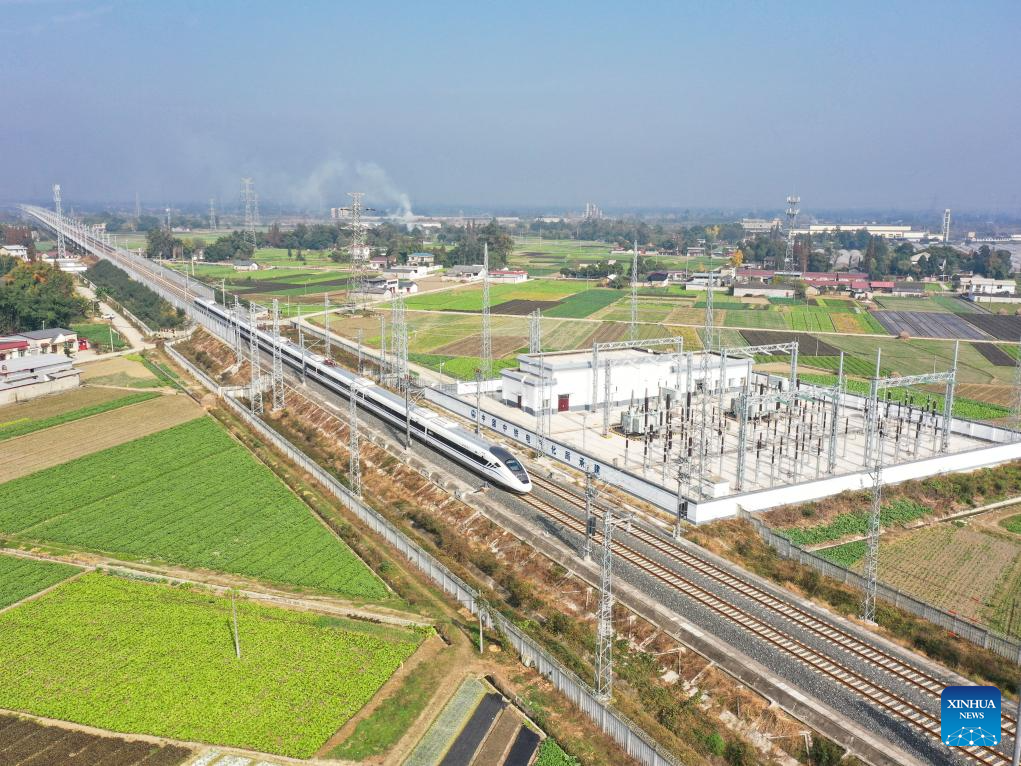
This aerial photo taken on Nov. 28, 2023 shows a high-speed passenger train running along the Sichuan-Qinghai railway. A 238-km section of the Sichuan-Qinghai railway in western China became operational on Tuesday after 12 years of construction.
The railway crosses the rugged, earthquake-prone plateau region in northwest Sichuan, and takes a detour to avoid disturbing the Giant Panda National Park.
The Sichuan-Qinghai railway will eventually stretch northwestward to Xining, the capital city of Qinghai Province. Upon completion of the whole project, the new rail line will connect the Qinghai-Tibet Plateau, the highest plateau in the world, into the massive high-speed transport network of China, which sets to put the region's development on fast track. (Photo by Ma Bo/Xinhua)
CHENGDU, Nov. 28 (Xinhua) -- A 238-km section of the Sichuan-Qinghai railway in western China became operational on Tuesday after 12 years of construction.
The first high-speed passenger train was launched at around 11 a.m. from Maoxian County, Aba Tibetan and Qiang Autonomous Prefecture of Sichuan Province, heading for Chengdu, the capital city of Sichuan.
The railway crosses the rugged, earthquake-prone plateau region in northwest Sichuan, and takes a detour to avoid disturbing the Giant Panda National Park.
Yongqingtsu, the conductor in charge of Tuesday's train service, described the trip of about an hour as "smooth and comfortable."
Because the railway is built mostly in mountains, "more than half of the journey is in tunnels, which is like riding the subway," he said. The constant change of elevations also makes the trip, at a speed of 170 km per hour in the tunnel, like riding a super long escalator, he added.
The tunnels were drilled through the famous Longmenshan fault zone, where a lot of devastating earthquakes had struck, including an 8.0-magnitude quake on May 12, 2008.
Wang Zhigang, who is in charge of construction projects undertaken by the China Railway 12th Bureau Group Co. Ltd., said engineers and builders had tackled numerous formidable obstacles with breakthroughs in technology and construction methods during 12 years of harsh work in the construction.
Another highlight of the railway construction is great attentions paid to the protection of the wild panda habitat. China officially launched the Giant Panda National Park in 2021 that covers parts of Sichuan, Shaanxi and Gansu provinces.
In order to minimize the impact on ecological corridors that are crucial to exchanges between different groups of giant pandas, the railway either makes detours or goes through tunnels as deep as possible, said Mu Yalin, of the China Railway Eryuan Engineering Group Co. Ltd., the designer of the project.
"Sometimes we need to do 20 percent extra work in the construction due to the special design," Mu said.
The Sichuan-Qinghai railway will eventually stretch northwestward to Xining, the capital city of Qinghai Province. Upon completion of the whole project, the new rail line will connect the Qinghai-Tibet Plateau, the highest plateau in the world, into the massive high-speed transport network of China, which sets to put the region's development on fast track.
The operational line has threaded through an array of cultural and scenic attractions such as the Jiuzhai Valley, a UNESCO World Heritage Site famed for its spectacular waterfalls, lush forests, serene plateau lakes and karst rock formations, and the famed Sanxingdui Ruins featuring the ancient Shu civilization dating back more than 3,000 years.
On Tuesday morning, Xiao Jiudan, a staff member at the Maoxian railway station, brought home-grown apples, a local specialty, to passengers as a gift for their maiden trip.
At an altitude of some 1,500 meters, Maoxian is the country's largest area inhabited by the people of Qiang ethnic group. They now have a new option of traveling by high-speed trains.
"When the railway was still under construction, I saw many investors coming to seek business opportunities. I'm sure that the railway will bring prosperity to my hometown," said Xiao. ■
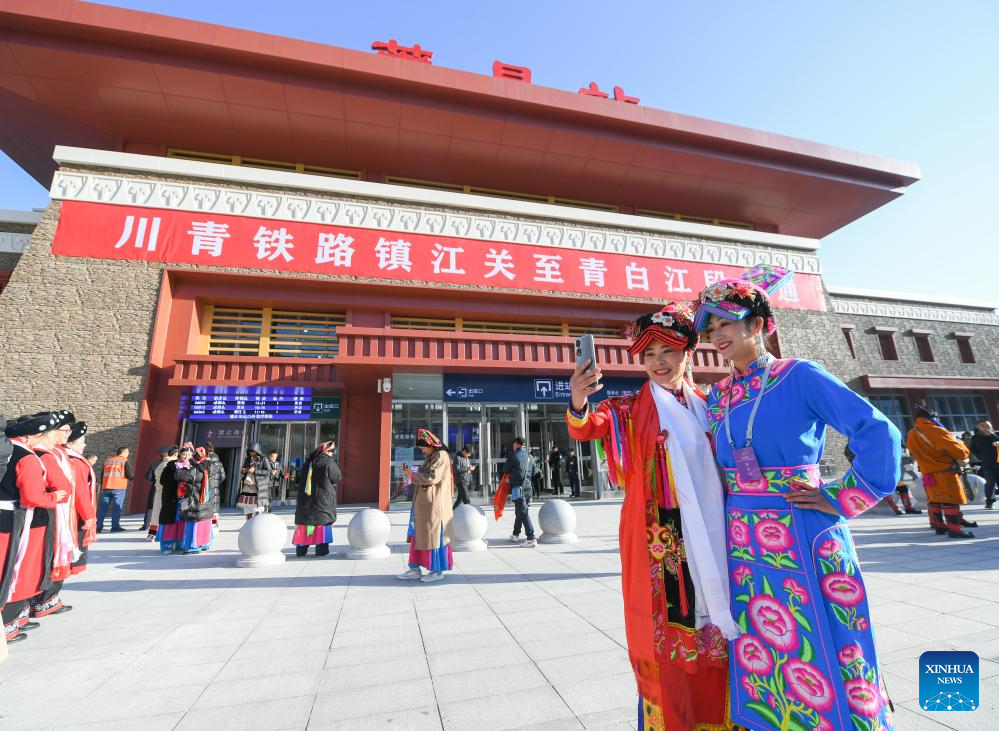
People pose for photos during the celebration for the operation of a section of the Sichuan-Qinghai railway at Maoxian railway station in Maoxian County, southwest China's Sichuan Province, Nov. 28, 2023. A 238-km section of the Sichuan-Qinghai railway in western China became operational on Tuesday after 12 years of construction.
The railway crosses the rugged, earthquake-prone plateau region in northwest Sichuan, and takes a detour to avoid disturbing the Giant Panda National Park.
The Sichuan-Qinghai railway will eventually stretch northwestward to Xining, the capital city of Qinghai Province. Upon completion of the whole project, the new rail line will connect the Qinghai-Tibet Plateau, the highest plateau in the world, into the massive high-speed transport network of China, which sets to put the region's development on fast track. (Xinhua/Wang Xi)
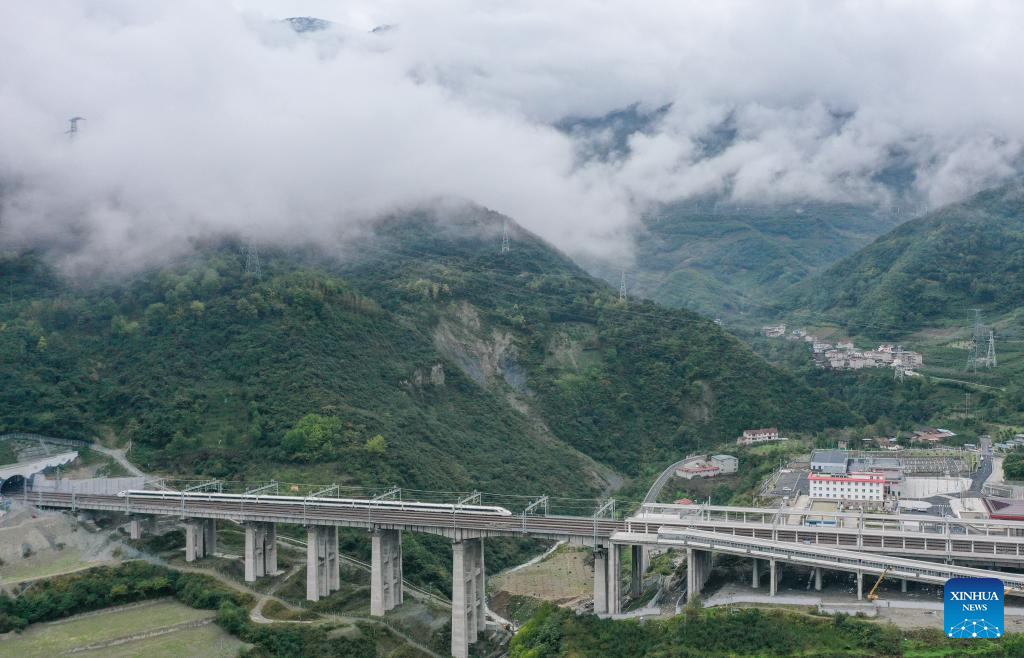
This aerial photo taken on Oct. 13, 2023 shows a train for commissioning and testing arriving at Maoxian railway station in Maoxian County, southwest China's Sichuan Province. A 238-km section of the Sichuan-Qinghai railway in western China became operational on Tuesday after 12 years of construction.
The railway crosses the rugged, earthquake-prone plateau region in northwest Sichuan, and takes a detour to avoid disturbing the Giant Panda National Park.
The Sichuan-Qinghai railway will eventually stretch northwestward to Xining, the capital city of Qinghai Province. Upon completion of the whole project, the new rail line will connect the Qinghai-Tibet Plateau, the highest plateau in the world, into the massive high-speed transport network of China, which sets to put the region's development on fast track. (Xinhua/Wang Xi)
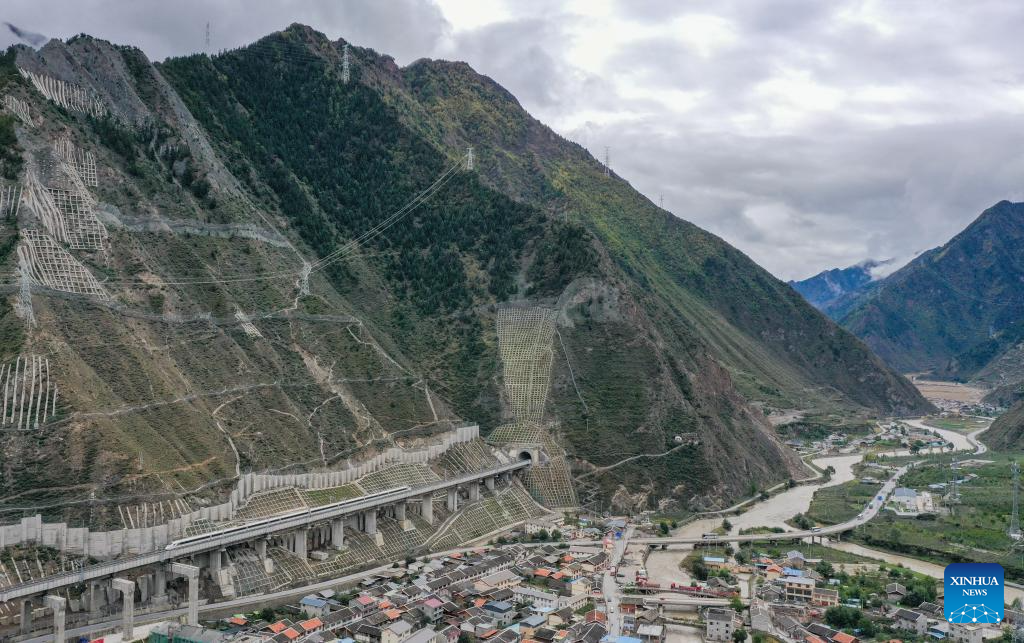
This aerial photo taken on Oct. 12, 2023 shows a train for commissioning and testing departing from Zhenjiangguan railway station in southwest China's Sichuan Province. A 238-km section of the Sichuan-Qinghai railway in western China became operational on Tuesday after 12 years of construction.
The railway crosses the rugged, earthquake-prone plateau region in northwest Sichuan, and takes a detour to avoid disturbing the Giant Panda National Park.
The Sichuan-Qinghai railway will eventually stretch northwestward to Xining, the capital city of Qinghai Province. Upon completion of the whole project, the new rail line will connect the Qinghai-Tibet Plateau, the highest plateau in the world, into the massive high-speed transport network of China, which sets to put the region's development on fast track. (Xinhua/Wang Xi)

This aerial photo taken on Nov. 13, 2023 shows a train for commissioning and testing running through Liutongzhai Tunnel in southwest China's Sichuan Province. A 238-km section of the Sichuan-Qinghai railway in western China became operational on Tuesday after 12 years of construction.
The railway crosses the rugged, earthquake-prone plateau region in northwest Sichuan, and takes a detour to avoid disturbing the Giant Panda National Park.
The Sichuan-Qinghai railway will eventually stretch northwestward to Xining, the capital city of Qinghai Province. Upon completion of the whole project, the new rail line will connect the Qinghai-Tibet Plateau, the highest plateau in the world, into the massive high-speed transport network of China, which sets to put the region's development on fast track. (Xinhua/Jiang Hongjing)
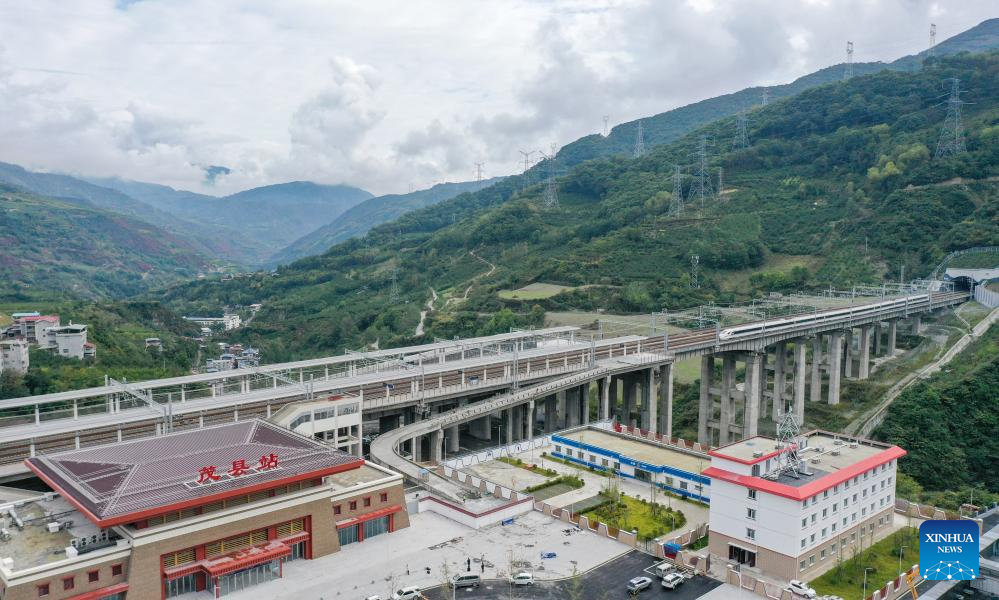
This aerial photo taken on Oct. 13, 2023 shows a train for commissioning and testing arriving at Maoxian railway station in Maoxian County, southwest China's Sichuan Province. A 238-km section of the Sichuan-Qinghai railway in western China became operational on Tuesday after 12 years of construction.
The railway crosses the rugged, earthquake-prone plateau region in northwest Sichuan, and takes a detour to avoid disturbing the Giant Panda National Park.
The Sichuan-Qinghai railway will eventually stretch northwestward to Xining, the capital city of Qinghai Province. Upon completion of the whole project, the new rail line will connect the Qinghai-Tibet Plateau, the highest plateau in the world, into the massive high-speed transport network of China, which sets to put the region's development on fast track. (Xinhua/Wang Xi)
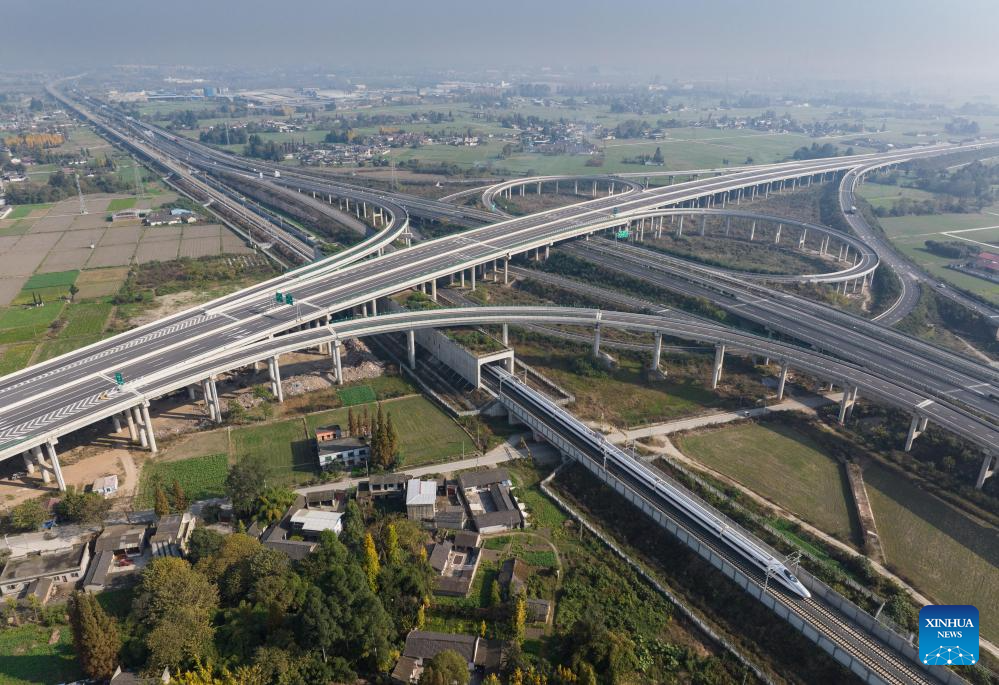
This aerial photo taken on Nov. 28, 2023 shows the first high-speed passenger train C6008 running along the Sichuan-Qinghai railway. A 238-km section of the Sichuan-Qinghai railway in western China became operational on Tuesday after 12 years of construction.
The railway crosses the rugged, earthquake-prone plateau region in northwest Sichuan, and takes a detour to avoid disturbing the Giant Panda National Park.
The Sichuan-Qinghai railway will eventually stretch northwestward to Xining, the capital city of Qinghai Province. Upon completion of the whole project, the new rail line will connect the Qinghai-Tibet Plateau, the highest plateau in the world, into the massive high-speed transport network of China, which sets to put the region's development on fast track. (Xinhua/Jiang Hongjing)
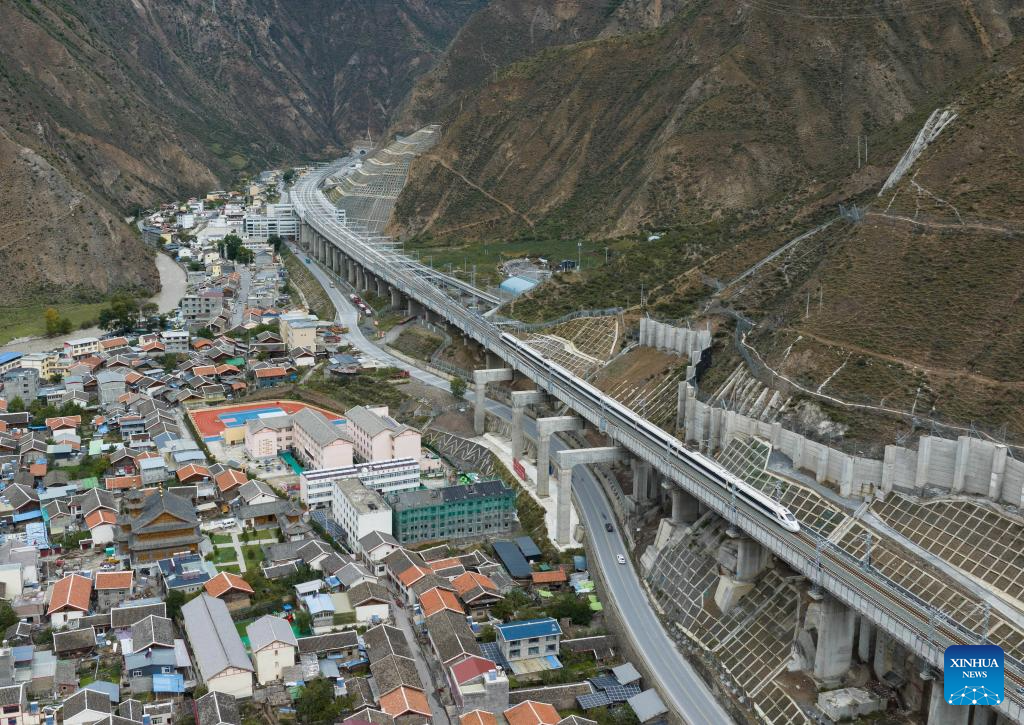
This aerial photo taken on Nov. 13, 2023 shows a high-speed passenger train departing from Zhenjiangguan railway station in southwest China's Sichuan Province. A 238-km section of the Sichuan-Qinghai railway in western China became operational on Tuesday after 12 years of construction.
The railway crosses the rugged, earthquake-prone plateau region in northwest Sichuan, and takes a detour to avoid disturbing the Giant Panda National Park.
The Sichuan-Qinghai railway will eventually stretch northwestward to Xining, the capital city of Qinghai Province. Upon completion of the whole project, the new rail line will connect the Qinghai-Tibet Plateau, the highest plateau in the world, into the massive high-speed transport network of China, which sets to put the region's development on fast track. (Xinhua/Jiang Hongjing)
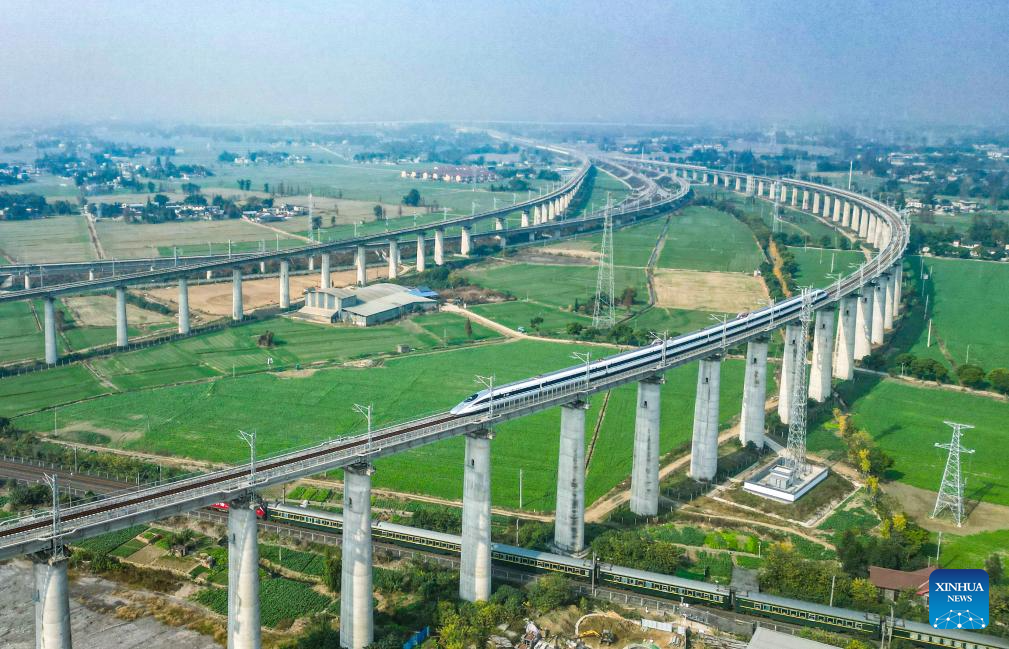
This aerial photo taken on Nov. 28, 2023 shows a high-speed passenger train running along the Sichuan-Qinghai railway (up) and a passenger train running along the Baoji-Chengdu railway (down) in Chengdu, southwest China's Sichuan Province. A 238-km section of the Sichuan-Qinghai railway in western China became operational on Tuesday after 12 years of construction.
The railway crosses the rugged, earthquake-prone plateau region in northwest Sichuan, and takes a detour to avoid disturbing the Giant Panda National Park.
The Sichuan-Qinghai railway will eventually stretch northwestward to Xining, the capital city of Qinghai Province. Upon completion of the whole project, the new rail line will connect the Qinghai-Tibet Plateau, the highest plateau in the world, into the massive high-speed transport network of China, which sets to put the region's development on fast track. (Xinhua/Wang Xi)

People pose for photos during the celebration for the operation of a section of the Sichuan-Qinghai railway at Maoxian railway station in Maoxian County, southwest China's Sichuan Province, Nov. 28, 2023. A 238-km section of the Sichuan-Qinghai railway in western China became operational on Tuesday after 12 years of construction.
The railway crosses the rugged, earthquake-prone plateau region in northwest Sichuan, and takes a detour to avoid disturbing the Giant Panda National Park.
The Sichuan-Qinghai railway will eventually stretch northwestward to Xining, the capital city of Qinghai Province. Upon completion of the whole project, the new rail line will connect the Qinghai-Tibet Plateau, the highest plateau in the world, into the massive high-speed transport network of China, which sets to put the region's development on fast track. (Xinhua/Wang Xi)

Performers sing on the first high-speed passenger train C6008 on a section of the Sichuan-Qinghai railway, Nov. 28, 2023. A 238-km section of the Sichuan-Qinghai railway in western China became operational on Tuesday after 12 years of construction.
The railway crosses the rugged, earthquake-prone plateau region in northwest Sichuan, and takes a detour to avoid disturbing the Giant Panda National Park.
The Sichuan-Qinghai railway will eventually stretch northwestward to Xining, the capital city of Qinghai Province. Upon completion of the whole project, the new rail line will connect the Qinghai-Tibet Plateau, the highest plateau in the world, into the massive high-speed transport network of China, which sets to put the region's development on fast track. (Xinhua/Wang Xi)

A performer presents a souvenir to a passenger on the first high-speed passenger train C6008 on a section of the Sichuan-Qinghai railway, Nov. 28, 2023. A 238-km section of the Sichuan-Qinghai railway in western China became operational on Tuesday after 12 years of construction.
The railway crosses the rugged, earthquake-prone plateau region in northwest Sichuan, and takes a detour to avoid disturbing the Giant Panda National Park.
The Sichuan-Qinghai railway will eventually stretch northwestward to Xining, the capital city of Qinghai Province. Upon completion of the whole project, the new rail line will connect the Qinghai-Tibet Plateau, the highest plateau in the world, into the massive high-speed transport network of China, which sets to put the region's development on fast track. (Xinhua/Wang Xi)
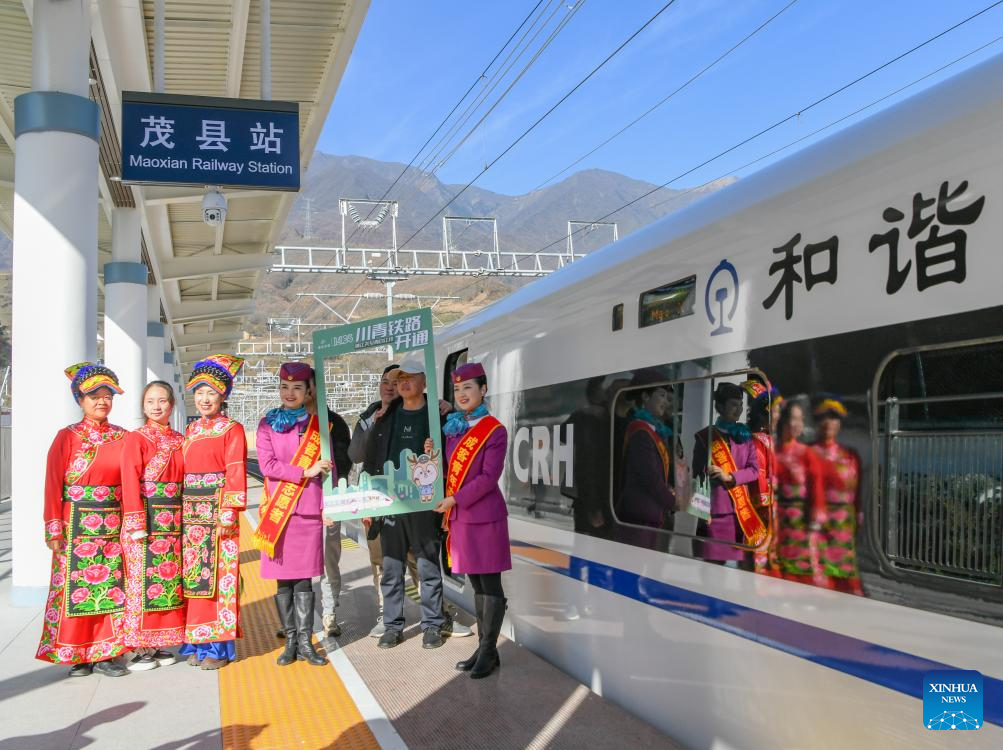
People pose for photos during the celebration for the operation of a section of the Sichuan-Qinghai railway at Maoxian railway station in Maoxian County, southwest China's Sichuan Province, Nov. 28, 2023. A 238-km section of the Sichuan-Qinghai railway in western China became operational on Tuesday after 12 years of construction.
The railway crosses the rugged, earthquake-prone plateau region in northwest Sichuan, and takes a detour to avoid disturbing the Giant Panda National Park.
The Sichuan-Qinghai railway will eventually stretch northwestward to Xining, the capital city of Qinghai Province. Upon completion of the whole project, the new rail line will connect the Qinghai-Tibet Plateau, the highest plateau in the world, into the massive high-speed transport network of China, which sets to put the region's development on fast track. (Xinhua/Wang Xi)
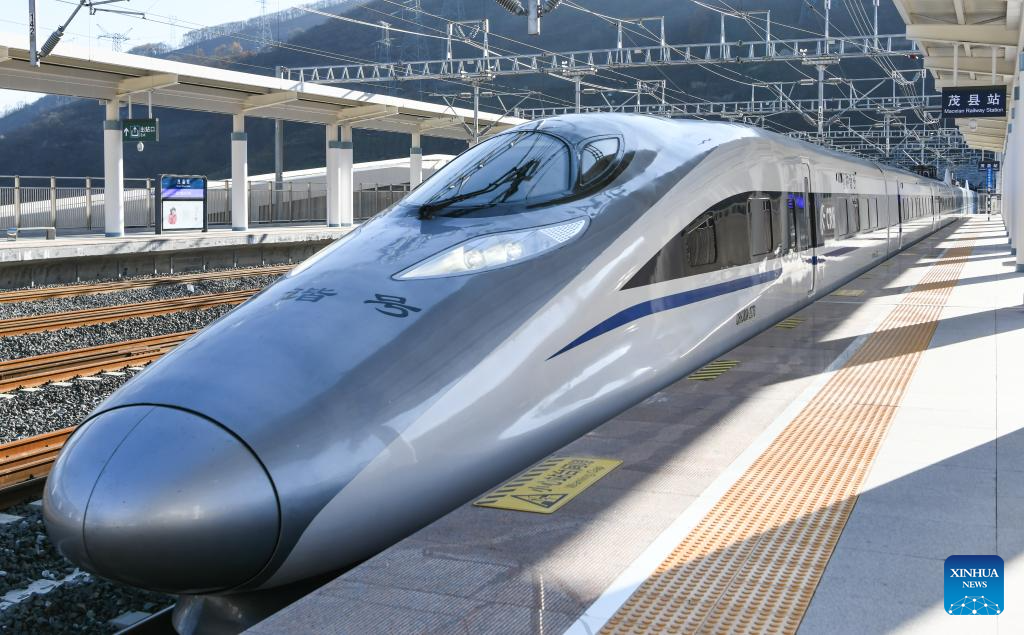
The first high-speed passenger train C6008 arrives at Maoxian railway station in Maoxian County, southwest China's Sichuan Province, Nov. 28, 2023. A 238-km section of the Sichuan-Qinghai railway in western China became operational on Tuesday after 12 years of construction.
The railway crosses the rugged, earthquake-prone plateau region in northwest Sichuan, and takes a detour to avoid disturbing the Giant Panda National Park.
The Sichuan-Qinghai railway will eventually stretch northwestward to Xining, the capital city of Qinghai Province. Upon completion of the whole project, the new rail line will connect the Qinghai-Tibet Plateau, the highest plateau in the world, into the massive high-speed transport network of China, which sets to put the region's development on fast track. (Xinhua/Wang Xi)
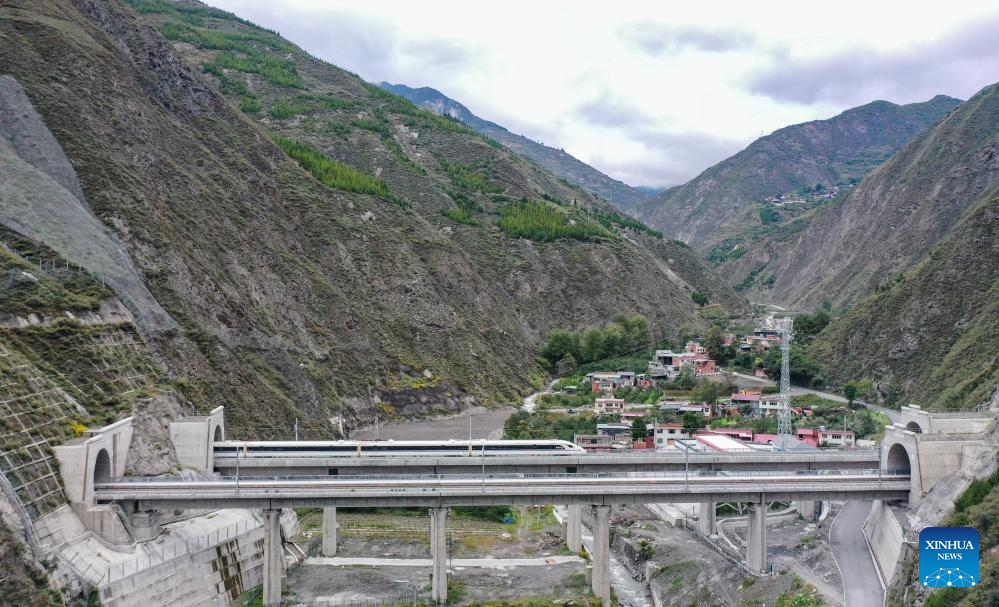
This aerial photo taken on Oct. 12, 2023 shows a train for commissioning and testing running through Liutongzhai Tunnel in southwest China's Sichuan Province. A 238-km section of the Sichuan-Qinghai railway in western China became operational on Tuesday after 12 years of construction.
The railway crosses the rugged, earthquake-prone plateau region in northwest Sichuan, and takes a detour to avoid disturbing the Giant Panda National Park.
The Sichuan-Qinghai railway will eventually stretch northwestward to Xining, the capital city of Qinghai Province. Upon completion of the whole project, the new rail line will connect the Qinghai-Tibet Plateau, the highest plateau in the world, into the massive high-speed transport network of China, which sets to put the region's development on fast track. (Xinhua/Wang Xi)
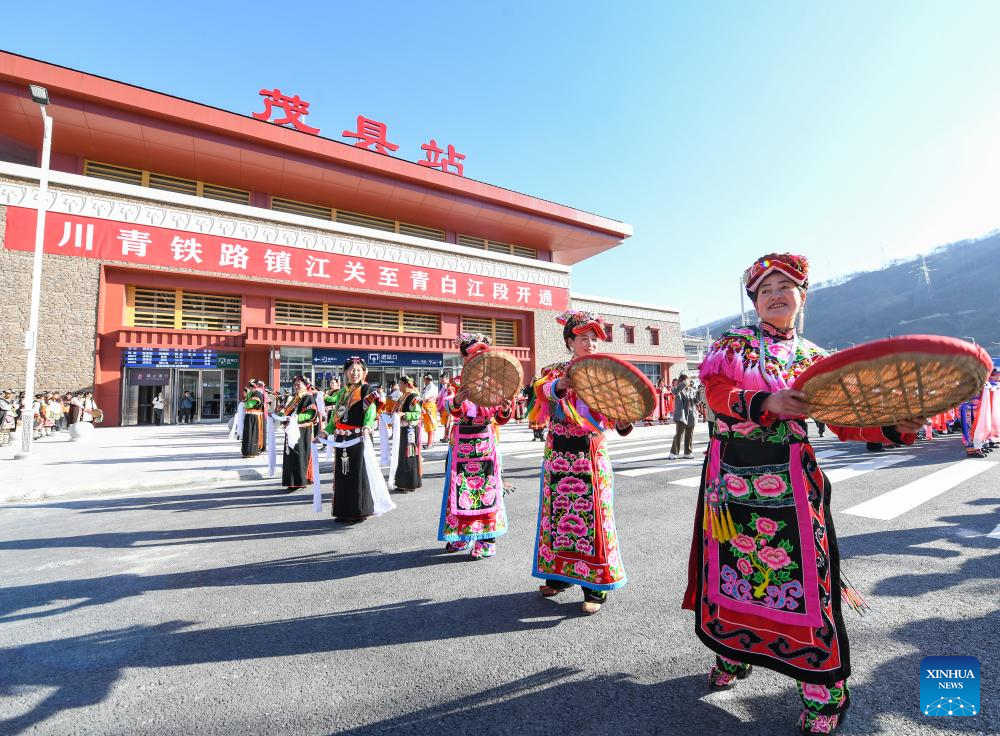
People celebrate the operation of a section of the Sichuan-Qinghai railway at Maoxian railway station in Maoxian County, southwest China's Sichuan Province, Nov. 28, 2023. A 238-km section of the Sichuan-Qinghai railway in western China became operational on Tuesday after 12 years of construction.
The railway crosses the rugged, earthquake-prone plateau region in northwest Sichuan, and takes a detour to avoid disturbing the Giant Panda National Park.
The Sichuan-Qinghai railway will eventually stretch northwestward to Xining, the capital city of Qinghai Province. Upon completion of the whole project, the new rail line will connect the Qinghai-Tibet Plateau, the highest plateau in the world, into the massive high-speed transport network of China, which sets to put the region's development on fast track. (Xinhua/Wang Xi)
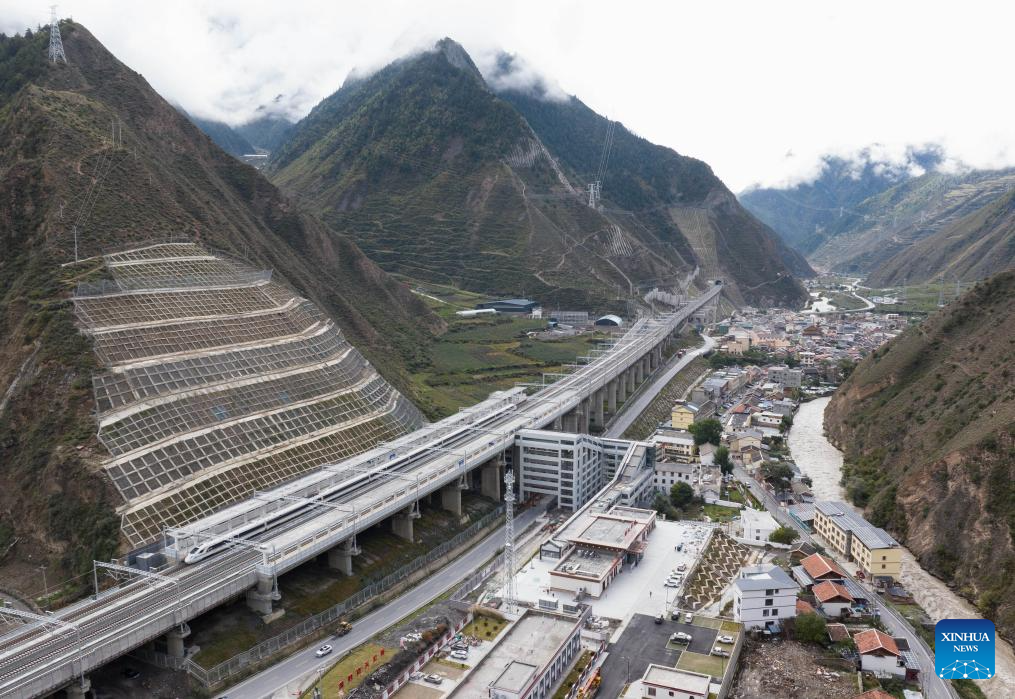
This aerial photo taken on Nov. 13, 2023 shows a high-speed passenger train making a stop at Zhenjiangguan railway station in southwest China's Sichuan Province. A 238-km section of the Sichuan-Qinghai railway in western China became operational on Tuesday after 12 years of construction.
The railway crosses the rugged, earthquake-prone plateau region in northwest Sichuan, and takes a detour to avoid disturbing the Giant Panda National Park.
The Sichuan-Qinghai railway will eventually stretch northwestward to Xining, the capital city of Qinghai Province. Upon completion of the whole project, the new rail line will connect the Qinghai-Tibet Plateau, the highest plateau in the world, into the massive high-speed transport network of China, which sets to put the region's development on fast track. (Xinhua/Jiang Hongjing)
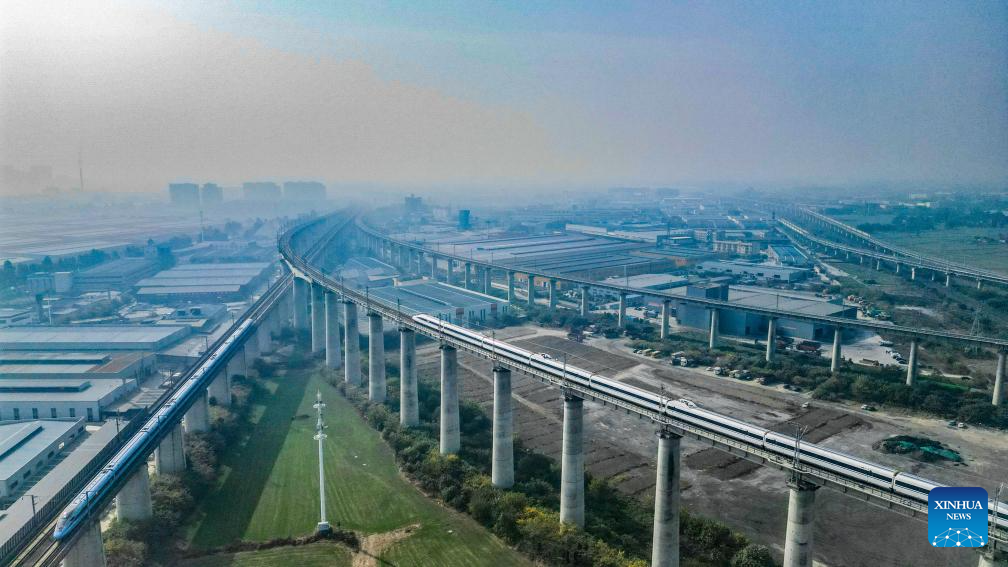
This aerial photo taken on Nov. 28, 2023 shows a high-speed passenger train running along the Sichuan-Qinghai railway (up) and a high-speed passenger train running along the Xi'an-Chengdu high-speed railway (down) in Chengdu, southwest China's Sichuan Province. A 238-km section of the Sichuan-Qinghai railway in western China became operational on Tuesday after 12 years of construction.
The railway crosses the rugged, earthquake-prone plateau region in northwest Sichuan, and takes a detour to avoid disturbing the Giant Panda National Park.
The Sichuan-Qinghai railway will eventually stretch northwestward to Xining, the capital city of Qinghai Province. Upon completion of the whole project, the new rail line will connect the Qinghai-Tibet Plateau, the highest plateau in the world, into the massive high-speed transport network of China, which sets to put the region's development on fast track. (Xinhua/Wang Xi)
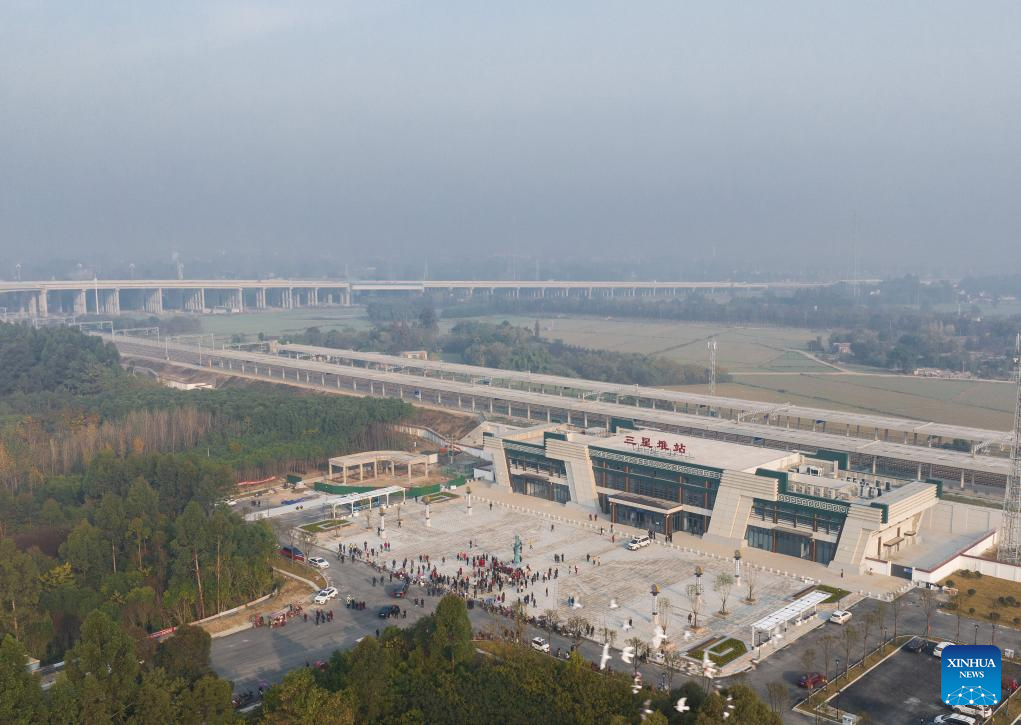
This aerial photo taken on Nov. 28, 2023 shows the Sanxingdui railway station along the Sichuan-Qinghai railway in southwest China's Sichuan Province. A 238-km section of the Sichuan-Qinghai railway in western China became operational on Tuesday after 12 years of construction.
The railway crosses the rugged, earthquake-prone plateau region in northwest Sichuan, and takes a detour to avoid disturbing the Giant Panda National Park.
The Sichuan-Qinghai railway will eventually stretch northwestward to Xining, the capital city of Qinghai Province. Upon completion of the whole project, the new rail line will connect the Qinghai-Tibet Plateau, the highest plateau in the world, into the massive high-speed transport network of China, which sets to put the region's development on fast track. (Xinhua/Jiang Hongjing)



